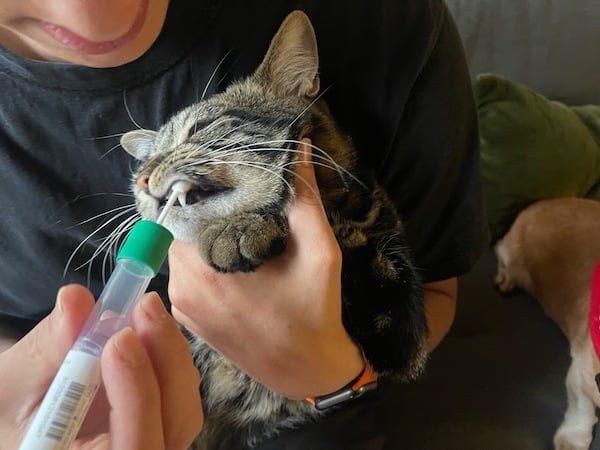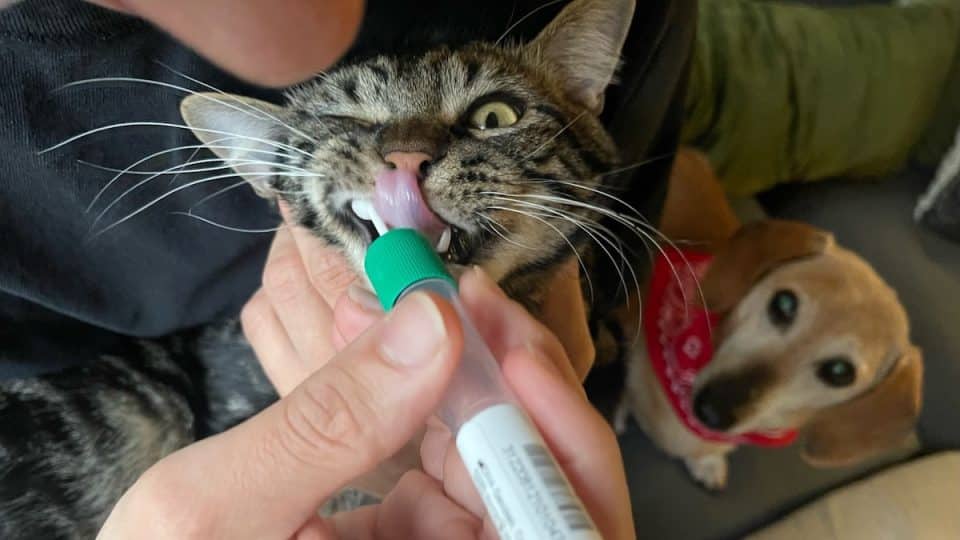- This post contains affiliate links. Read more here.
- Not a substitute for professional veterinary help.
We received a free Basepaws Oral Health Test and a Breed + Health DNA Test in exchange for an honest review.
For a lot of cat parents, their furry friend’s ancestry is a tantalizing mystery. What breeds make up their mix, and what can genetics explain about their personality and preferences? With pet parenthood playing a bigger role in people’s lives than ever, it’s not surprising that cat DNA tests are on the rise.
So we put popular petcare genetics company Basepaws to the test. With the help of Zorian the cat, we discovered that DNA testing can do more than satisfy curiosity. Knowing your cat’s genetic makeup might help you make better medical choices for your pet, get preventive care, and advance feline genetics research the world over.
In this review, we break down how Basepaws works, what we thought of our testing experience, and why we think petcare genetics is worth considering—even just for fun.
What a Basepaws Cat DNA Test Offers
Basepaws offers cat parents their choice of three different DNA tests, each of which is geared toward slightly different goals.
| Test | Price | Results |
| Oral Health Test | $99 |
|
| Breed + Health DNA Test | $159 |
|
| Whole Genome Test | $499 |
|
The Oral Health Test flags indicators of dental disease in high-risk kitties
The Oral Health Test samples the microbes in your cat’s mouth to evaluate their risk for three primary dental issues: periodontal disease, bad breath, and tooth resorption. Untreated dental illnesses in cats can be dangerous, both in its own right and because it’s associated with increased risks for other health issues, like kidney disease.
The Oral Health Test is the most affordable of the three currently on offer from Basepaws, and pet parents with at-risk kitties are encouraged to repeat it at intervals of four to six months to see how their treatment plan is progressing.

Zorian’s pet parents aren’t sure about the report’s positive assessment of his breath but will take the win.
Interestingly, the Basepaws oral health report will sometimes include an additional note about trace DNA from plants and animals found in a cat’s mouth—either because it’s something they’re hunting in the wild or because they’re snatching snacks off the table. Zorian was found guilty of eating wheat, which did not surprise his pet parents, who know well his fondness for toast.
He was also encouraged to begin a nightly toothbrushing routine and check back with another test in six months.
The Breed + Health DNA Test identifies your cat’s breed and assesses genetic risks
Cat breeds don’t work like dog breeds. As Rowyn Rose, Director of Science and Research Communications at Basepaws, tells us, “Unlike cats, dogs have undergone thousands of years of selective breeding for specific behavioral and physical traits. The selective breeding of cats for certain desirable traits [has] been primarily aesthetic in nature (e.g., white coat color, long coat length, blue eyes), and this breeding has a comparatively short history of only 50 to 100 years. From an evolutionary perspective, our concept of the purebred cat is a very new one.”
A genetic test, then, will be looking not so much for purebred ancestors as for points of similarity between the tested cat and the genomes of modern-day pure breeds.
To build a base for comparison, Basepaws fully sequenced the genome of 21 pedigree breeds, which they then classified into four groups:
- Western (from Europe/Americas)
- Eastern (from Asia)
- Persian (Persian and related cats)
- Exotic (hybrids and Egyptian Mau)
Each cat is identified as belonging primarily to one of these groups, and a Breed report will describe the breakdown of your cat’s representation within that category.

Zorian combines the best qualities of all cats, we are sure.
You’ll also receive an oral health report as part of the package, plus an analysis of your cat’s genetic health and trait markers.
Basepaws will scan for 64 different genetic markers that are associated with an increased likelihood of developing one of 43 genetic disorders. Your cat will be designated:
- “Clear,” meaning they have no copies of the tested genetic markers
- “Carrier,” in which case your cat is unlikely to develop the disease but could pass it on to their offspring
- “At risk,” which means your cat has one copy of a marker that puts them at risk, though the disease’s presentation might be less severe than if they had two
- “At high risk” suggests your cat is very likely to develop the disease, either because one marker is all it takes to cause the health condition or because they have more than one marker, worsening its probable presentation
You’ll also see a star rating next to each one of the genetic disorders that were tested for. A five-star rating indicates strong confidence in the results based on a wide body of research; a one-star rating indicates that the finding is based on less developed research that may require further study.

Zorian has zero copies of genetic markers that would predispose him to hypertrophic cardiomyopathy (hooray!).
It’s important to note that having a genetic marker doesn’t mean your cat is guaranteed to develop the disease—research in these areas is relatively new, and there’s still a lot to learn. But it does suggest that the likelihood of developing it has increased, and it’s a good idea to take the results and your cat to the vet for an in-depth exam.
By the same token, being given a clear bill of genetic health doesn’t mean it’s impossible for your cat to wind up with the disorder down the line (it’s possible that environmental factors can contribute to some of these illnesses).
The Whole Genome Test is for science lovers
The Whole Genome Test is Basepaws’ most expensive test, delivering the raw data of a cat’s full genome. It offers everything the Breed + Health DNA Test does, plus a thumb drive with the raw data of your cat’s entire genome.
Why would a cat parent want that? Rose elaborates: “Many of our non-science/research customers who do purchase a WGS test do this as a donation to feline genetics research in the long term. Some of these WGS customers have cats with terminal illness, so it’s a way for them to know that something good for all cats could come out of studying their cats’ genomes.”
The WGS also offers customers free report updates for life on all health and trait markers and breed results.
Note that it takes up to 9 weeks (as opposed to the usual 4 to 6) to receive WGS results, since sample quality checks are required before sequencing can begin.
How do you get your cat’s DNA?
The process is straightforward: You’ll purchase your kit, and when it arrives in the mail, you’ll use its bar code to create a Basepaws account and register it.
Next, you’ll use the included swab to rub your cat’s gums and teeth (a process Zorian found objectionable but worth a few freeze-dried minnows—a lot like his nightly cat teeth-brushing). The swab then goes into a tube filled with stabilizing liquid. After a quick shake, the whole thing can be packed up and shipped back to the company for free. Results arrive in your inbox in 4 to 6 weeks.

Zorian wants to know what the Basepaws DNA test will require of him before he signs on.
Review: Why You Might Want To Consider a Cat DNA Test
Cat DNA testing won’t be for every pet parent. For one, it’s expensive, with even the most affordable oral test costing roughly $100—with regular re-testing often encouraged.
It’s also possible some pet parents might be disappointed by the results of the breed analysis. Because the feline genetic code has remained remarkably diverse, in comparison with dog breed analysis, cat breed profiles can look a little muddy.
It’s worth noting too that deciphering the diseases associated with genetic markers is tricky; the results are only as good as the research behind them, and there’s still a lot to learn. You’re dealing with probabilities and possibilities, not promises.
But after our test with Zorian, we think there are some really good reasons to consider a cat genetic test if it’s in the budget.
Cats mask pain.
That can make it really hard to catch their diseases in the early stages. Both the oral and genetic tests can help you catch serious illnesses before they progress, when there may still be a lot you can do to treat or mitigate them. You could add years to your cat’s life.
Untreated dental issues can lead to other serious problems.
The oral health test doesn’t just flag potential issues; it can also flag active ones based on the bacteria, viruses, and fungi currently in your cat’s mouth. And as Rose points out, untreated developing dental disease can lead to other systemic diseases, including diabetes, a heart condition, and kidney disease.

What big teeth you have, Zorian.
Knowing your cat’s breed profile can help you make health decisions.
Different cat breeds are prone to different health issues. Ragdolls and Maine Coons, for example, are genetically predisposed to hypertrophic cardiomyopathy, a silent killer that rarely manifests obvious symptoms. A cat with a high percentage of Ragdoll or Maine Coon DNA will likely want to screen for HCM regularly (as in the case of Basepaws cat Samson).
Finally, your cat’s DNA test can help cats around the world and further vital research.
As Rose points out, “Feline genetics is considered a nascent field of study—historically underfunded and underrepresented in science.” For cats, that means there are a lot of health problems they can run into that don’t yet have solutions. The more cat genomes Basepaws and others sequence, the better scientists can understand the health predispositions unique to different breeds.
“That’s one of the many reasons why feline genetics is such an exciting field of study—it’s a journey of discovery that every single pet parent and their cats contribute to when they join the Basepaws community.”
Basepaws even has a no-cost citizen science research program aimed at understanding the genetics behind common diseases, like feline diabetes, to one day develop early detection screening tests.
That’s the coolest part for Zorian’s pet parents: getting to be part of feline genetics research that can help future Zorians the world over. Not that there could ever be another Zorian. (The world, and its supply of buttered toast, couldn’t handle it.) He’s unique—and now they have the DNA to prove it.

Snooze long and prosper, Zorian!
Find on Basepaws Find on Amazon



